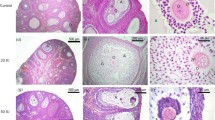Abstract
Exogenous gonadotropin releasing hormone (GnRH) and its agonistic analogs appear to display a marked antigonadotropic activity, interfering with luteinizing hormone (LH)-in-duced synthesis of progesterone by the developing corpus luteum in a variety of species (1). In cattle, administration of GnRH has been shown to reduce serum progesterone concentrations during the estrous cycle without causing luteal regression (2,3). This action of GnRH appears to be linked to the downregulation of luteal LH receptors (3). Loss of LH receptors and subsequent gonadal desensitization following treatment with GnRH was initially attributed to GnRH-induced release of LH (4). However, the presence of high-affinity binding sites for GnRH in the ovaries of the rat (5) and the antisteroidogenic effect of this decapeptide in hypophysectomized rats (6) has implicated a possible direct action of GnRH on the mammalian ovary. Recently, an ovarian protein (GLOH) which binds to rat GnRH receptors has been isolated from the ovaries of the ewe and the cow (7). While gonadal GnRH receptors have been identified in the rat, specific binding sites for this decapeptide have not been found in domestic species (8). Therefore, the mechanism by which GnRH reduces luteal steroidogenesis in domestic species remains enigmatic.
Access this chapter
Tax calculation will be finalised at checkout
Purchases are for personal use only
Preview
Unable to display preview. Download preview PDF.
Similar content being viewed by others
References
Hsueh AJW, Jones PBC. Extrapituitary actions of gonadotropin-releasing hormone. EndocrRev 1981; 2:437–61.
Lucy MC, Stevenson JS. Gonadotropin-releasing hormone at estrus: luteinizing hormone, estradiol and progesterone during the periestrual and postinsemination periods in dairy cattle. Biol Reprod 1986; 35:300–11.
Rodger LD, Stormshak F. Gonadotropin-releasing hormone induced alteration of bovine corpus luteum function. Biol Reprod 1986; 35:149–56.
Cusan L, Auclair C, Belanger A, et al. Inhibitory effects of long term treatment with a luteinizing hormone-releasing hormone agonist on the pituitary-gonadal axis in male and female rats. Endocrinology 1979; 104:1369–76.
Clayton RN, Harwood JP, Catt KJ. Gonadotropin-releasing hormone analogue binds to luteal cells and inhibits progesterone production. Nature 1979; 282:90–3.
Hsueh AJW, Erickson GF. Extrapituitary action of gonadotropin-releasing hormone: direct inhibition of ovarian steroidogenesis. Science 1979; 204:854–5.
Aten RF, Ireland JJ, Weems CW, Behrman HR. Presence of gonadotropin-releasing hormone-like proteins in bovine and ovine ovaries. Endocrinology 1987; 120:727–33.
Brown JL, Reeves JJ. Absence of specific luteinizing hormone releasing hormone receptors in ovine, bovine and porcine ovaries. Biol Reprod 1983; 29:1179–82.
McCarthy MS, Swanson LV. Serum LH concentration following castration, steroid hormone and gonadotropin releasing hormone treatment in the male bovine. J Anim Sci 1976;43:151–8.
Koligian KB, Stormshak F. Progesterone synthesis by ovine fetal cotyledons in vitro. J Anim Sci 1976; 42:439–43.
Schwall RH, Gamboni F, Mayan M, Niswender GD. Changes in the distribution of sizes of ovine luteal cells during the estrous cycle. Biol Reprod 1986; 34:911–8.
Farin CE, Moeller CL, Mayan H, Gamboni F, Sawyer HR, Niswender GD. Effect of luteinizing hormone and human chorionic gonadotropin on cell populations in the ovine corpus luteum. Biol Reprod 1988; 38:413–21.
Suter DE, Fletcher PW, Sluss P, Reichert LE Jr, Niswender GD. Alterations in the number of ovine luteal receptors for LH and progesterone secretion induced by homologous hormone. Biol Reprod 1980; 22:205–10.
Author information
Authors and Affiliations
Editor information
Editors and Affiliations
Rights and permissions
Copyright information
© 1989 Plenum Press, New York
About this chapter
Cite this chapter
Slayden, O., Stormshak, F. (1989). Attenuated In Vivo Progesterone Secretion by Ovine Corpora Lutea After Exposure to Luteinizing Hormone. In: Hirshfield, A.N. (eds) Growth Factors and the Ovary. Springer, Boston, MA. https://doi.org/10.1007/978-1-4684-5688-2_52
Download citation
DOI: https://doi.org/10.1007/978-1-4684-5688-2_52
Publisher Name: Springer, Boston, MA
Print ISBN: 978-1-4684-5690-5
Online ISBN: 978-1-4684-5688-2
eBook Packages: Springer Book Archive




